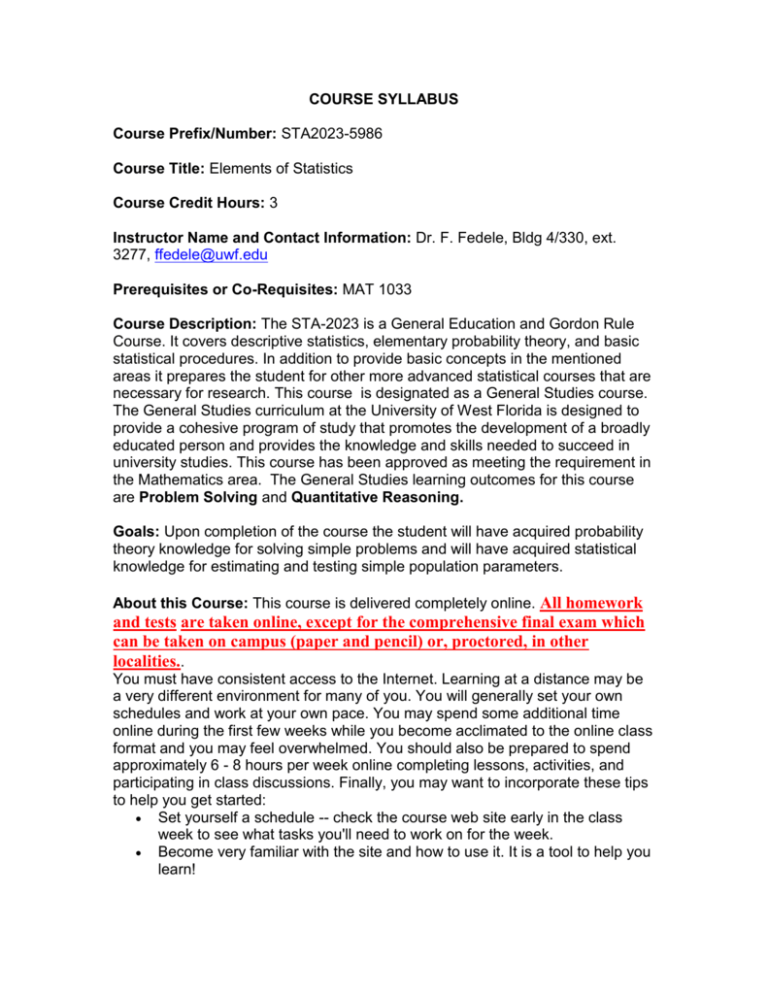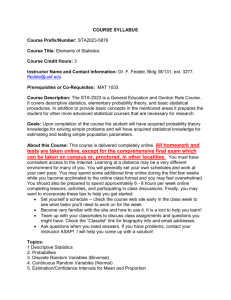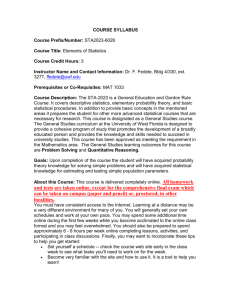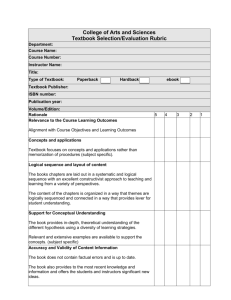COURSE SYLLABUS - University of West Florida
advertisement

COURSE SYLLABUS Course Prefix/Number: STA2023-5986 Course Title: Elements of Statistics Course Credit Hours: 3 Instructor Name and Contact Information: Dr. F. Fedele, Bldg 4/330, ext. 3277, ffedele@uwf.edu Prerequisites or Co-Requisites: MAT 1033 Course Description: The STA-2023 is a General Education and Gordon Rule Course. It covers descriptive statistics, elementary probability theory, and basic statistical procedures. In addition to provide basic concepts in the mentioned areas it prepares the student for other more advanced statistical courses that are necessary for research. This course is designated as a General Studies course. The General Studies curriculum at the University of West Florida is designed to provide a cohesive program of study that promotes the development of a broadly educated person and provides the knowledge and skills needed to succeed in university studies. This course has been approved as meeting the requirement in the Mathematics area. The General Studies learning outcomes for this course are Problem Solving and Quantitative Reasoning. Goals: Upon completion of the course the student will have acquired probability theory knowledge for solving simple problems and will have acquired statistical knowledge for estimating and testing simple population parameters. About this Course: This course is delivered completely online. All homework and tests are taken online, except for the comprehensive final exam which can be taken on campus (paper and pencil) or, proctored, in other localities.. You must have consistent access to the Internet. Learning at a distance may be a very different environment for many of you. You will generally set your own schedules and work at your own pace. You may spend some additional time online during the first few weeks while you become acclimated to the online class format and you may feel overwhelmed. You should also be prepared to spend approximately 6 - 8 hours per week online completing lessons, activities, and participating in class discussions. Finally, you may want to incorporate these tips to help you get started: Set yourself a schedule -- check the course web site early in the class week to see what tasks you'll need to work on for the week. Become very familiar with the site and how to use it. It is a tool to help you learn! Team up with your classmates to discuss class assignments and questions you might have. Check the Classlist link for biography info and email addresses. Ask questions when you need answers. If you have problems, contact your instructor ASAP! I will help you come up with a solution! Topics: 1 Descriptive Statistics 2. Probabilties 3. Discrete Random Variables (Binomial) 4. Continuous Random Variables (Normal) 5. Estimation/Confidence Intervals for Mean and Proportion 6 Hypotheses Testing for Mean and Proportion 7. Hypotheses Testing for Differences of Population Means and Proportions Student Learning Outcomes: 1. Demonstrate the ability to Display and Describe Data (Topic 1) Build Frequency Distributions, Stem and Leaf Display, and Box Plot Graph Bar Graphs and Histograms Compute Measure of Centrality (mean, median, and mode) Compute Measures of Dispersions (standard deviation and range) Compute Measures of Location (percentiles, quartiles, z-score) Apply the Empirical Rule 2. Demonstrate the ability to apply Probabilities Rules in solving problems (Topic 2) Apply the Definition of Probability Solve problems requiring the application of formulae for Probability of Union of Events and Intersection of Events Solve problems requiring the application of formulae for Conditional Probabilities 3. Demonstrate the ability to apply rules for Discrete Random Variables in solving problems (Topic 3) Build Probability Distributions Tables of Discrete Random Variables Compute Mean and Standard deviations of Discrete Random Variables Calculate Expectation of Discrete Random Variables for simple experiments Use the Binomial Formula and Binomial Tables to solve problems 4. Demonstrate the ability to apply rules for Continuous Random Variables in solving problems (Topic 4) Use Z Tables for finding probabilities for the Normal Distribution Calculate probabilities of Normally Distributed Random Variables Apply probabilities for Normally Distributed Random Variables in solving problems Use the Normal Distribution to approximate probabilities for Binomial Random Variables Calculate probabilities for the Sample Mean 5. Demonstrate the ability to apply rules for Estimation of Parameters (Topic 5) Find Confidence Intervals for the Population Mean (large and small sample) and the Population Proportion Determine the Sample Size for estimating Population Mean and Population Proportion Find Confidence Intervals for Differences of Population Means (large and small samples) and Differences of Population Proportions 6. Demonstrate the ability to apply Hypotheses Testing for one Population (Topic 6) Test Hypotheses about the Population Mean (large and small sample) Population Proportion Test Hypotheses about the Population Proportion 7. Demonstrate the ability to apply Hypotheses Testing for two Populations (Topic 6) Test Hypotheses about the Difference of Population Means (large and small for Independent Samples and for Paired Data Test Hypotheses about the Difference of Population Proportions Texts: Course Textbook: Beginning Statistics (Warren, Denley, and Atchley) Textbook and Software Bundle, ISBN: 1-932628-12-6 or Statistics Software Only, ISBN: 0-918091-31-4. Available from UWF Bookstore http://www.bkstr.com/, or from Hawkes Learning sistems ttp://hawkespublishing.stores.yahoo.net/statistics.html Hawkes Learning Systems (HLS) is the publisher's multimedia software to support this on-line course. Your Beginning Statistics Textbook and Software Bundle contains the CD to access the HLS Statistics Software (instructions at http://www.hawkeslearning.com/default.htm) which provides lessons and tutorials, generates practice problems, administers assignments to test students' skills for each section, and administers tests. All your online assignments, tutorial work and tests are tracked in your HLS gradebook. You are given the option of purchasing the Statistics Software Only (CD to access HLS Statistics Software), You can also download the software and purchase the access code online at http://www.hawkeslearning.com/ Instructor's Notes are an additional source of content for this course (available on D2L). They consist of a concise, yet complete collection of concepts and formulae, accompanied by examples. It is suggested that students learn the assigned material by reading both instructor's notes and textbook and by getting lessons instruction on HLS. Grading / Evaluation: The course grade will be determined as follows: Homework 25% of final grade Three Tests 45% of final grade Comprehensive final exam: 30% of final grade Information for students on taking a proctored exam is available at: http://uwf.edu/atc/Guide/Developing/DesignStandards/assessment/Proctor.cfm. Students who live on-campus or its proximity can take the final exam on campus (Wednesday, August 8).Only a formula sheet, tables, and calculator are allowed while taking tests and final exam. Grades assigned according the following scale: 90-100 A or A80-89 B+, B, or B- 70-79 C+, C, or C- 60-69 D+ or D Less than 60 F Special Technology Utilized by Students: 1. UWF e-Learning (DL2) website access through Argus. 2. Hawkes Learnig Systems Statistical Software Hawkes Learning System TO INSTALL THE HLS SOFTW ARE: 1. Place CD #1 Installation Disc in the CD-ROM drive. 2. The installation will begin automatically. Follow the on-screen instructions. 3. You will be prompted to enter a HLS Course ID. The course ID is UWFSTAT TO GET YOUR ACCESS CODE: 1. Either go to www.hawkeslearning.com and click on get your access code or click on the I need an access code link from the software. 2. Fill out the form (including your 15-digit license number from the yellow sticker on the CD sleeve). Click on the submit button and your personalized Access Code will appear on the screen. You will also receive an e-mail with the Access Code as an attachment called access.cod which you should save. TO ENTER THE SOFTWARE AND SAVE YOUR ACCESS CODE: 1. Double-click on the purple diamond icon on your Desktop (or go to Start, Programs, Hawkes Learning Systems). 2. Enter your Access Code when prompted. You may type it, paste it, or load it from a disk by clicking the Load From Disk option. If you type or paste your Access Code, you will be prompted to save it. Save your Access Code to avoid typing it each time. TO ENROLL IN YOUR INSTRUCTORS GRADEBOOK: 1. If you have internet access and have entered your HLS Course ID (which is UWFSTAT), you will be asked to enroll in your instructor's gradebook. Choose your instructor's name (Franco Fedele) and the correct section (STA2023-5986). TO CERTIFY (DO YOUR ASSIGNMENT IN THE SOFTWARE): 1. The Certify option is where you will complete your assignment. 2. After certifying, you will be given a certification code (this verifies that you completed your assignment). It is recommended that you save and/or print your certification code. You should receive a message that says your certificate for the lesson has been registered successfully. Contact Tech. Support at (800)-426-9538 for assistance This course is totally online. All instructional content and interaction takes place over the WWW. In addition to baseline word processing skills and sending/receiving email with attachments, students will be expected to search the internet and upload / download files. In addition, students may need one or more of the following plug-ins: Adobe Acrobat Reader: http://www.adobe.com/products/acrobat/readstep2.html PowerPoint Viewer: http://microsoft.com/downloads/details.aspx?FamilyId=D1649C22B51F-4910-93FC-4CF2832D3342&displaylang=en Quicktime Player: http://www.apple.com/quicktime/download/ Macromedia Flash Player: http://macromedia.com/shockwave/download/download.cgi?P1_Prod_Ver sion=ShockwaveFlash Expectations for Academic Conduct/Plagiarism Policy: Academic Conduct Policy: (Web Format) | (PDF Format) | (RTF Format) Plagiarism Policy: (Word Format) | (PDF Format) | (RTF Format) Student Handbook: (PDF Format) ASSISTANCE: Students with special needs who require specific examination-related or other courserelated accommodations should contact Dr. Vannee Cao-Nguyen, Assistant Director of Student Disability Resource Center (SDRC), sdrc@uwf.edu, (850) 474-2387. SDRC will provide the student with a letter for the instructor that will specify any recommended accommodations. Information can also be found on the website www.uwf.edu/sdrc. Withdrawal Policy: Withdrawal deadline: 7/19 (Automatic grade of W). Late withdrawal deadline : 8/9 (W or WF, see the requirements below). Students who are requesting a late withdraw from class, must have the approval of the advisor, instructor, and department chairperson (in that order) and finally, by the Academic Appeals committee. Requests for late withdraws may be approved only for the following reasons (which must be documented): a) a death in the immediate family, b) serious illness of the student or an immediate family member, c) a situation deemed similar to categories a) and b) by all in the approval process, d) withdrawal due to Military Service (Florida Statute 1004.07), and e) National Guard Troops Ordered into Active Service (Florida Statute 250.482). Requests without documentation should not be accepted. Requests for late withdraws simply for not succeeding in a course, do not meet the criteria for approval and should not be approved. WEATHER EMERGENCY INFORMATION In the case of severe weather or other emergency, the campus might be closed and classes cancelled. Official closures and delays are announced on the UWF website and broadcast on WUWF-FM.Weather Emergency Information WUWF-FM (88.1MHz) is the official information source for the university. Any pertinent information regarding closings, cancellations, and the re-opening of campus will be broadcast. In the event that hurricane preparation procedures are initiated, the UWF Home Web Page and Argus will both provide current information regarding hurricane preparation procedures, the status of classes and the closing of the university. Emergency plans for the University of West Florida related to inclement weather are available on the following UWF web pages: Information about hurricane preparedness plans is available on the UWF web site:http://uwfemergency.org/hurricaneprep.cfmInformation about other emergency procedures is available on the UWF web site:http://uwfemergency.org/ Course Schedule 6/126/17 Session 1 1. Textbook/HLS: Chapter 1 Introduction to Statistics 1.1 Getting Started 1.2 Data Classification Certification: 1.1, 1.2 Certification: 2.1, 2.2a, 2.2b 2. Textbook/HLS: Chapter 2 Graphical Description of Data 2.1Frequency Distributions 2.2 Graphical Display of Data 6/18-6/23 Session 2 1. Textbook/HLS: Chapter 3 Numerical Description Certification: 3.1, 3.2a, 3.3 of Data 3.1Measures of Center 3.2 Measures of Dispersion 3.3Measures of relative position Certification: 4.1, 4.2a, 4.2b 2. Textbook/HLS: Chapter 4 Probability, Randomness, and Uncertainty 6/24-7/1 4.1 Classical Probability 4.2 Probability Rules Session 3 1. Textbook/HLS: Chapter 5 Probability Distribution Certification: 5.1, 5.2 5.1 Expected Value 5.2 Binomial Distribution TEST 1 (6/28-7/1) 7/2-7/8 Session 4 1. Textbook/HLS: Chapter 6 Continuous Random Variables Certification: 6.2, 6.3, 6.4, 6.5 Certification: 7.2 6.2 Reading a Normal Curve Table 6.3 Finding Probability Using the Normal Curve 6.4 Finding z Values Using the Normal Curve 6.5 Finding t values Using the Student tDistribution 2. Textbook/HLS: Chapter 7: Samples and Sampling Distributions 7/9-7/15 7.2 Central Limit theorem with Population Means Session 5 3.Textbook/HLS: Chapter 8: Confidence Intervals 8.1 Introduction to estimating the population mean 8.2 Estimating Population Means (Large Samples) 8.3 Estimating Population Means (Small Samples) 8.4 Estimating Population Proportions Certification: 8.1, 8.2, 8.3, 8.4 7/167/22 7/237/29 Session 6 1. Textbook/HLS: Chapter 9 Confidence Interval for Certification: 9.1, 9.2, 9.4 Two Samples 9.1 Comparing Two Means (Large, Independent Samples) 9.2 Comparing Two Means (Small, Independent Samples) 9.4 Comparing Two Proportions (Large, Independent Samples 1 Session 7 1. Textbook/HLS: Chapter 10 Hypothesis Testing TEST 2 (7/19-7/22) Certification: 10.1, 10.2, 10.3, 10.4 10.1 Fundamentals of Hypothesis Testing 10.2 Hypothesis Testing for Means (Small Samples) 7/30-8/5 10.3 Hypothesis Testing for Means (Large Samples) 10.4 Hypothesis Testing for Population Proportions Session 8 1. Textbook/HLS: Chapter 11 Hypothesis Testing (Two or more Populations) 11.1 Hypothesis Testing-Two Means (Large, Independent Samples) 11.2 Hypothesis Testing-Two Means (Small, Independent Samples) 11.3 Hypothesis Testing-Two Means (Dependent Samples) 11.4 Hypothesis Testing-Two Proportions Certification: 11.1, 11.2, 11.3, 11.4 TEST 3 (8/2-8/5) 8/6-8/7 Session 9 FINAL EXAM (8/7)





